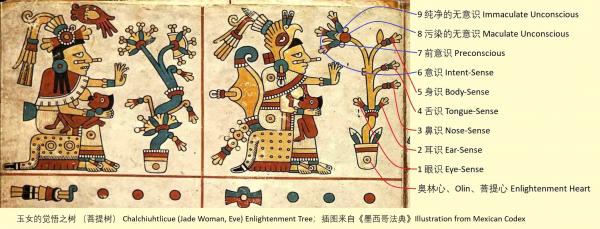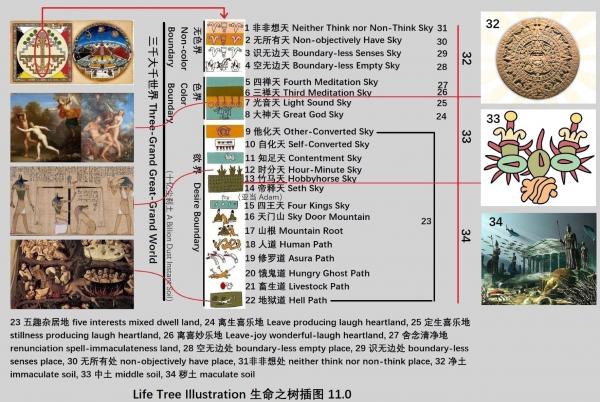| 11.4.5 識蘊 Sense Node |
| 送交者: 盧岩 2023年07月03日09:22:19 於 [健康生活] 發送悄悄話 |
|
識,義為了別,共有八位:1眼識、2耳識、3鼻識、4舌識、5身識、6意識、7前意識、8無意識。其中,第七識前意識,亦作意處,是前六識的移動工作平台;第八識無意識是前七識的總根,亦作本識。如插圖11.4.5-1所示,前六識都積累了一體行為習氣;識蘊就是此六識行為習氣體的總和。 Sense means “clearly distinguishing”; has eight faculties: 1 eye-sense, 2 ear-sense, 3 nose-sense, 4 tongue-sense, 5 body-sense, 6 intent-sense, 7 preconscious, and 8 unconscious. Seventh sense preconscious, is also as Intent-place, is front six senses’ mobile working platform. Eighth sense unconscious is general root of all front seven senses. As illustration 11.4.5-1 shows, earlier six senses, each accumulates a node of habits; Sense Node is sum of those six nodes of habits.
識就是思想意識,就是心;更具體地說,識有三義:了別名識;思量名意;集起名心。 Sense is meaning, is heart; more specifically, sense has the three significances: 1) “clearly distinguishing” is named as Sense, 2) “meaning and measuring” is named as Intent, 3) “aggregate arousal” is named as heart. 什麼是“集起”?答:集起有三義,即能集,所集,集起。能集,是說心能收集、儲藏諸法的種子。所集,義為心即是那些收集來的諸法的種子。集起,是說心能將成熟的種子發起,現行,使其成為現時身口意的行為;更具體的解釋參見本書的14.1節《集起》。 What is the “aggregate arousal”? Answer: it has three significances: 1) heart is capable to aggregate juristic seeds, 2) heart is those juristic seeds aggregated, 3) heart can arouse mature seeds into performance, let them become present bodily orally or mentally behaviors; more specific explanation refers to section 14.1 Aggregate Arousal. 11.4.5-1 前六識 Front Six Senses 了別就是明了地辨別。(1)眼識,即見色之 見。(2)耳識, 即聞聲之聞。(3)鼻識, 即嗅香之嗅。(4)舌識, 即嘗味之嘗。(5)身識,即感觸之感。(6)意識, 即知法之知。此六識,即見、聞、嗅、嘗、感、知之義,還有六情之名。 The earlier six senses’ functions are clearly discernment. (1) Eye sense, that is, the seeing of seeing colors. (2) Ear sense, that is, the hearing of hearing sounds. (3) Nose sense, that is, the smell of smelling fragrance. (4) Tongue sense, that is, the tasting of tasting of tasting tastes. (5) Body sense, that is, the feeling of the flesh body. (6) Intent-sense, that is, the knowing of comprehension on laws. The six senses are exactly seeing, hearing, smelling, tasting, feeling, and knowing; and they also have name of “six feelings”. 11.4.5.1-1 與心所有法的相應 Correlation to Heartland Laws 前五識(眼識、耳識、鼻識、舌識、身識)與34位心所有法相應:遍行5(觸、作意、受、想、思);別境5(欲、勝解、念、定、慧);善11(信、精進、慚、愧、無貪、無嗔、無痴、輕安、不放逸、行舍、不害);根本煩惱3(貪、嗔、痴);中隨煩惱2(無慚、無愧),大隨煩惱8(不信、懈怠、放逸、昏沉、掉舉、失念、不正知、散亂)。 The former five senses (eye-sense, ear-sense, nose-sense, tongue-sense, and body-sense) match with 34 heartland laws. 5 omnipresent heartland laws (touch, attention, acceptation, think, and mean); 5 circumstantial heartland laws (desire, resolution, spell, stillness, and gnosis); 11 benevolent heartland laws (faith, shame, sin [remorse], non-greed, non-irritation, ignorance-less, diligently advance, ease, non-indulgence, renunciation, harmlessness); 3 fundamental annoyances (greed, irritation, and ignorance); 2 medium latent annoyances (shameless and sinless); 8 large latent annoyances (depression, drowsiness, non-belief, slack, indulgence, lost spell, agitation, and improper know). 第六識(意識)與51位心所有法(參見行蘊)都相應。 Sixth sense, Intent-sense matches all 51 heartland laws (refers to migration node). 11.4.5.1-2 與環境的相應 Correlation to Environments 八識所緣境有三種:性境、獨影境、帶質境。 Environments aggregated by eight senses can be categorized into the three types: 1) nature environment, 2) solitary-head environment, 3) environment with quality. 一 性境,即有自身性質的境,從實種生,有實體用。能緣之心,得彼自性顯相,名為性境,具足五義:一、從現量所得;二、有仗質,比如聲音必須有耳聽聞的質;三、從自種生,不是從能見種直接生出來的;四、有實際的功能和用途;五、其性質與界系不隨能緣心的改變而改變。 Nature environment, that is, an environment with its own nature, which is born from a real seed and has a physical use. Manifestation shown by aggregately heart obtained counterpart nature is named as Nature Environment, has five aspects of significance: 1) gained from present-quantity; 2) have supportive medium, such as sounds must have hearable medium; 3) born from its own seed, not from the aggregately heart born directly; 4) it has practical functions and uses; 5) its nature and boundary system do not change with the change of the capable heart (i.e., mind). 二 獨影境,即能緣心單獨成相,心自己成相,沒有別的本質。獨影境的存在依於內濾所託。本書12《禪》中講的都是獨影境。 Solitary-head environment is projected by its own heart alone, without other stimuli or nature, such as hallucination, dream, and occasionally popping out thoughts in loose mind. The environments’ formations are correspondingly following thinker’s opinions, and its existence rely on thinker’s inner thoughts. The book’s chapter 12 Meditation inclusively talks solitary-head environment. 三 帶質境,謂能緣心緣所緣境,有所杖質而不得自相,謂之帶質境。一、真帶質,以心緣心名真帶質,即第六識通緣一切心及心所,及第七識單緣第八識之見分是也。二、似帶質,以心緣色名似帶質,謂帶彼相起,有似彼質,如依經作觀,非是五識所緣現境故也。 Environment with quality, the objective environment is with medium quality, isn’t its own phenomena; has two types: (1) really with quality, (2) similarly with quality. (1) really with quality, from heart to aggregate heart, is named as “really with quality”. That is, sixth sense aggregates all other hearts or heartland laws; and seventh sense (i.e., preconscious) aggregates eighth sense’s second quadrant (view quadrant). (2) similarly with quality. From heart to aggregate color, is named as “similarly with quality”; the saying is that the environment is aroused with objective, has similar quality of that objective, such as according to sutra to make view, those aren’t front five senses’ objective environments. 至於前六識所對是哪一種境,前五識為緣性境;第六意識通緣這三種境。 In respect of front six senses’ correlation to the three types of environments, front five senses’ counterparts all are first type: nature environments. Sixth sense can aggregate all the three types of environments. 11.4.5.1-3 與三量的相應 Correlation to Three Quantities 八種識所發所得的量有三種:現量、比量、非量。 There are three kinds of quantities produced or received by the eight senses; the three are: present-quantity, metaphysical-quantity, and non-quantity. 一 現量,能緣之心量所緣之境,沒有分別計度的情況下所獲之量果。現量具有三個條件:一、是現在時,以簡別於過去或未來;二、心識認識的對象必須要顯現出來,亦即必須是現行位之法,種子不能成為現量;三、現有,在能所位上,即能量之心與所量之境,二者俱是明白現前,和合俱有。 Present-Quantity, during aggregative heart is measuring objective environment, the resulted fruit before any discrimination and measurement is present-quantity. Necessarily, Present Quantity should satisfy the three conditions: (1) it is present, neither past nor future; (2) the being cognized component must be on manifestation; (3) on presentation aspect, the aggregative heart and the being measured environment, both should be on lucidly manifestation, are dependent mutually. 二 比量,是通過推測比度而獲致的量果。如見山上有煙,推知該處必有火;見牆外有雙角,推知牆外有牛。 Metaphysical-Quantity is speculating measuring fruit from reference, such as you see smoke on the mountain, you can infer that there must be fire there; you see two horns outside the wall, you can infer that there are some cattle outside the wall. 三 非量,似現量和似比量統稱為非量。似現量是和現量相似的量,但不是那種現量的事實。似現量,謂有分別智,於境異化而取量。如有智者知道花瓶衣服等,因為對待和分別而生,由彼於義,不以自相為境界故。似比量是不太恰當的比喻量。似比量,依似因智為先,所起相似之義,如於山中誤認為霧是煙而推度,那裡有火。再比如,看見一個栩栩如生的石頭獅子,心生恐懼,不認為它只是一塊石頭。不能正解,是真之流而非真,名似比量。 Non-Quantity is collectively referred to “similar present-quantity” and “similar metaphysical- quantity”. A “similar present- quantity” is a quantity that is like a real quantity but is not a fact of that kind. Similar Present Quantity, that is, discriminating intelligence differentially fetches quantity, such as, a wise man who knows that vases and clothes are born because of treatment and distinction, those are not by self-phenomena as its realm. A Similar Metaphysical-Quantity is from an inappropriate metaphor. Similar Metaphysical-Quantity, according to preconceptual intelligence wisdom first, the meaning of similarity arises, such as mistaking the fog in the mountains for smoke and inferring that there is fire there. For another example, when seeing a lifelike stone lion, one feels fear and does not think it is just a stone. It isn’t correct, is from factual stream but not real, is named as Similar Metaphysical-Quantity. 前五識唯是現量;第六識中三種量都有。 In respect of former six senses’ correlation to the three Quantities, front five senses (i.e., eye-sense, ear-sense, nose-sense, tongue-sense, and body-sense) only match to the Present-Quantity. Sixth sense, Intent-sense, can process all the three types of quantities. 11.4.5.1-4 八識與道德的相應 Correlation to ethics 道德性可被簡化為三種:善性、惡性、無記性。 Ethical natures can be categorized as the three: good nature, evil nature, memoryless nature.
一 善,能為此世及它世受益的行為。眼耳等前六識有善性。 Good, an action that benefits this world and others. Former six sense (i.e., eye-sense, ear-sense, nose-sense, tongue-sense, body-sense, and intent-sense) all have good nature. 二 惡,能為此世及它世造成損害的行為。眼耳等前六識有惡性。 Evil, an action that can cause harm in this world and in other worlds. All former six senses have evil nature. 三 無記,道德上中性,不善不惡的行為會留下無記業,即無記憶的業或稱淨業。無記有兩種:有覆無記,無覆無記。 Memoryless nature, morally neutral, neither good nor evil behavior will leave no record karma, what memoryless nature is! Memoryless karma is also being called immaculate karma. What is karma? Answer: karma is the three karmas: bodily karma, oral karma, and intentional karma. Bodily karma is bodily behaviors’ habitual deposits, what the flesh body is. Oral karma is lingual habitual deposits, what the mouth’s speaking is. Intentional karma is habitual deposits of intents, what the mental thinks are. Memoryless nature has two types: (1) convertible memoryless, (2) nonconvertible memoryless. 一) 有覆無記,這是在說第七識,前意識,其行為是染污但不產生善惡業,此稱無記。前意識的記憶像似計算機的內存,隨時更新變化,此說前意識的有覆性。 Convertible memoryless, that is saying of seventh sense (i.e., intent, preconscious), its behaviors are pollutions, don’t produce good or evil karma, that is called “no record” (memoryless). Preconscious memory is like the memory of a computer, it is updated and changed at any time, which means that preconscious is convertible. 二)無覆無記,這是在說第八識。許多無意識的性質終生不變,且其不辨善惡,本性非染,亦非善惡,故名無記,即無記憶。無覆,是說一個人從出生到死亡,一切都會被無意識記憶,無論這個人的思想意識記得還是不記得,它過去的經歷記憶都會發生作用。 Nonconvertible memoryless, is saying of eighth sense (unconscious). Many unconscious properties remain unchanged throughout life, and it does not distinguish between good and evil, its nature is not contaminated, nor good or evil, so it is called memoryless, that is, without recallable memory. Nonconvertible means that everything from birth to death of a person will be remembered unconsciously, regardless of whether the person's consciousness remembers it or not, its past experiences all have effects on present and future life. 八識當中,第八識是無覆無記性;第七識是有覆無記性。眼耳等前六識這三種性質都有,於善法中,它們表現為善性;於惡法,它們就是惡性。 Among eight senses, eighth sense (unconscious, also God-sense) is nonconvertible memoryless, seventh sense (preconscious, also Eve-sense) is convertible memoryless. Eye-sense, ear-sense etc. six former senses have all the three ethical natures; that is saying, among good laws, they appear as good nature; in evil laws, they show as evil qualities.
11.4.5.1-5 八識與三界九地的相應 Correlation to Three Boundaries Nine Heartlands 三界九地參見插圖11.0或本書的第13章苦諦。 一 鼻舌(和男女的性感覺)二識只在欲界有,不通上界。二 眼、耳、身三識,唯在 “五趣雜居地” 和 “離生喜樂地” ,此兩地存在。第三地及以上,前五識(眼耳鼻舌身)全無。三 第六識意識,第七識前意識,和第八識無意識遍三界九地而有。 Nose-sense, (sexual sense), and tongue-sense exist in desire boundary only. Three boundaries nine heartlands refer to illustration 11.0 or chapter 13. Eye-sense, ear-sense, and body-sense exist in “five interests mixed dwell heartland” and “leave producing laugh heartland”, the two lands. Sixth sense (intent-sense), seventh sense (i.e., preconscious), and eighth sense (i.e., unconscious) exist in all the three boundaries nine heartlands. 11.4.5-2 前意識 Preconscious 前意識,佛教作末那識,神教作夏娃識,古人說其自身細微難辨,故用常隨之而起的“意”來指代前意識。意是思量、意圖、打算義;是第六識意識的根。前意識是思想意識的工作平台,隨着意圖的變化不斷地自我更新着。 Preconscious is called Mana in Buddhism, and Eve in Islam and Christianity. Ancients said that it is subtle and difficult to distinguish, so they use its major companion "Intent" to represent it. Therefore, we call Preconscious as Intent in Buddhism. Preconscious is root for six former senses, is ever updating work platform of mind, which is constantly updating itself with the change of intention.
古人常用 “步屈蟲(尺蠖)” 來比喻前意識的行為特點。步屈蟲移動時,後腳總是抓着些什麼;前腳在尋找落腳點,思忖着。前腳抓穩後,後腳跟進。這樣它的移動像是在丈量。前意識的特點與步屈蟲非常類似,也總是思量着。移動時,前意識也總是執着些什麼東西;此執着就是人思想內的很微小的“自我”。這個“小我” ,漢語作福,佛教作儒童,印度教作婆羅門(Bramin),伊斯蘭教和基督教作亞伯(Abel)。 Ancients often used "measuring worm (inchworm)" to describe its behaviors. When inchworm moves, its hind feet are always grabbing something; its front feet are looking for a foothold, meaning. After the front foot is firmly grasped, the back foot follows. The way its moves as if measuring. Preconscious’ moves are very similar to those, and it means always. Preconscious is also always attached to something when moving; this attachment is the very tiny "inner ego" of human. The "small self" is called Fortune (福) in Chinese, “genius kid” in Buddhism, Brahmin in Hinduism, Abel in Islam, and Christianity. 另外,前意識對語言的形成有促進作用,所以古人也稱之為 “增語觸”,義為對語言有增上的作用。 In addition, preconsciousness can promote the formation of language, so ancients also called it "escalatory feeler", which means that it escalates language. 1) 與心所有法的相應 correlation to heartland laws 前意識與18位心所有法相應:根本煩惱4(貪、痴、我見、慢);遍行5(觸、作意、受、想、思);別境1(慧);大隨煩惱8(不信、懈怠、放逸、惛沉、掉舉、失念、不正知、散亂)。 Preconscious match with 18 heartland laws: 5 omnipresent heartland laws (touch, attention, acceptation, think, and mean), 1 circumstantial law (gnosis), 4 fundamental annoyances (greed, ignorance, arrogance, translocating body views), and 8 large latent annoyances (depression, drowsiness, non-belief, slack, indulgence, lost spell, agitation, and improper know). 2) 與環境的相應 Correlation to Three Environments 前意識的所緣境界全是帶質境。 All environments aggregated by preconscious are “environment with quality” (refer to section 11.4.5.1-2). 3) 與三量的相應 Correlation to Three Quantities 前意識僅與非量相關聯。 Preconscious correlates to non-Quantity (refers to section11.4.5.1-3) only. 4) 與道德的相應 Correlation to Three Ethics 前意識的道德性是 “有覆無記性”。 Preconscious’ ethical nature is “convertible memoryless” (refers to section 11.4.5.1-4). 5) 與九地的相應 Correlation to Nine Heartlands 前意識普遍存在於三界九地,當然四禪天的無想天除外。 Preconscious exists in all three boundaries nine heartlands (refers to section 11.4.5.1-5), certainly excludes “non-think sky” in fourth meditation skies. 11.4.5-3 無意識 Unconscious 無意識最大的特點是異熟。異熟是說無意識中的種子受熏變異而成熟。變異即是成熟,能持業故。又,第16章道諦中述說了無意識的另外十種特性,即十真如。 The most outstanding character of unconscious is mutation. Mutation is saying that juristic seeds in unconscious are being smoked into maturity. Mutation is mature because mutations can keep karmas. And chapter 16 of the book talks about ten kinds of true suchness, which are other ten characters of unconscious. 1) 與心所有法的相應 Correlation to Heartland Laws 無意識只與5位遍行心所有法(觸、作意、受、想、思)相應。 Unconscious only matches with 5 omnipresent heartland laws (touch, attention, acceptation, think, and mean). 2) 與環境的相應 Correlation to Environments 無意識的所緣境界全是性境。 Whatever environments aggregated by unconscious are “nature environments” (refer to section 11.4.5.1-2). 3) 與三量的相應 Correlation to Three Quantities 無意識只處理現量。 Unconscious processes present-Quantity (refers to section11.4.5.1-3) only. 4) 與道德的相應 Correlation to Ethics 無意識的道德性是 “無覆無記”。 Unconscious’ ethical nature is “nonconvertible memoryless” (refers to section 11.4.5.1-4). 5) 與九地的相應 Correlation to Nine Heartlands 無意識普遍存在於三界九地。 Unconscious exists in all three boundaries nine heartlands (refers to section 11.4.5.1-5). ↪️返回第11章🎄生命之樹的目錄↪️Back to Catalog of Chapter 11🎄Tree of Life |
|
|
 |
 |
| 實用資訊 | |
|
|
| 一周點擊熱帖 | 更多>> |
| 一周回復熱帖 |
| 歷史上的今天:回復熱帖 |
| 2022: | 分享第一批31種醫學辭書(Txt格式) | |
| 2022: | 事能知足心常樂,人到無求品自高 | |
| 2021: | 台灣同胞真有才,大疫出大作,氣樂蘇東 | |
| 2021: | 人間之情猶如一張網,我們自己在編織 | |
| 2020: | 糖尿病一定要看洋蔥降血糖食譜 | |
| 2020: | 深入分析Lyons-Weiler“新冠來自實驗室 | |







